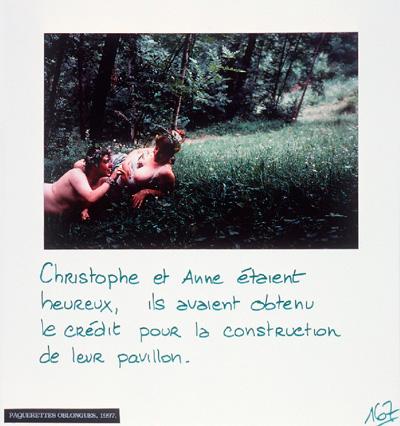
Mireille Loup, kitsch, humour and humanity
Mireille Loup belongs to the new generation of photographers who grab reality as it is, without any fantasies or effects, with a taste for direct flash and an intentionally common take of ordinary people. However, this young artist differentiates herself from the actual tendency for her striking humour and a conception ranging between the mockery of kitsch and the hard critics towards our society.
First of all she places herself « on stand » and then her relatives in a sort of everyday chronicle made out of archetype situations. Her first series Each one of my faces, started in 1992, depicts her in all her phantoms, her realities and caricatures. There we can find the portrait of the star, the nymph, the young girl crying or laughing, and also the conceited and the alcoholic. Surely we can identify a certain influence in it. It is not disguised. Quite on the contrary it goes beyond it, in an intimate still probably softer and more merciless work. Actually, it is very far from Cindy Sherman’s narcissism, with her sumptuous settings and costumes, her cinema light effects or her magnificent huge size cibachrome photographs. The spectator is faced here with an almost miniature-size band where the value of each postcard-shape portrait lies really in its contiguity with the other faces, acting as an on-going questioning about the deep self by « what has been »* frozen by the photographic instant.
If ever Mireille Loup acts, this happens in her video Henry (1994), when she simulates the existential discomfort on her wash-basin, when she declares her love with a ragamuffin look or when she bursts into tears in an « Almodovar like » crisis. The « observer » starts by laughing, by actually laughing out, and then, comparing the video with the set of self-portraits, he evaluates this work. The audio-visual gags are fragile love declarations to the same character Henry, forwarding the spectator to his own doubts and yearnings. The discomfort grows on when, confronted with the group Each one of my faces, there is a feeling that this sequence of self-portraits will continue. Until when? Until death, no doubt, as this is a to be continued series.
This way she offers an intimate personal understanding of our contemporary society by constructing « false evidences », a sort of virtual events which plunge the spectator into his own existential discomfort and his own difficulty of adaptation to social demands. This questioning reveals in its ambivalent nature, the inadequacies of our times. Exceeding itself by humour, it can either move the spectator or chock him and make him react against something that dares confront him with his own vulgarity, beyond everyday triviality. In any case, if Mireille Loup manages to succeed her intention it is only because by means of her irony and taste for provocation, she actually tells us about ourselves, by sending us back to our nostalgic lost paradise.
As a matter of fact, despite a bit of cynicism, there is a poetic sense along all this work, thus permeating the author to resist to a « hard reality » as if she was tried to annihilate the events she refers to. The emblematic simulation she photographs end up by changing into counter-events whose first reality vanishes in benefit of an exutory imagination.
*La chambre Claire, Roland Barthes, author note.
Christine Ollier, 1998 in Catalogue Encontros da Imagem, Portugal.
